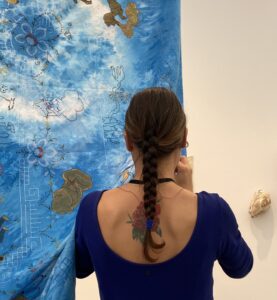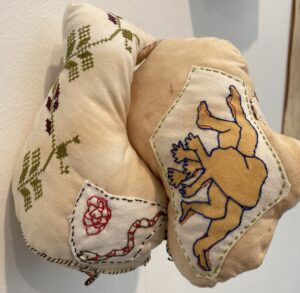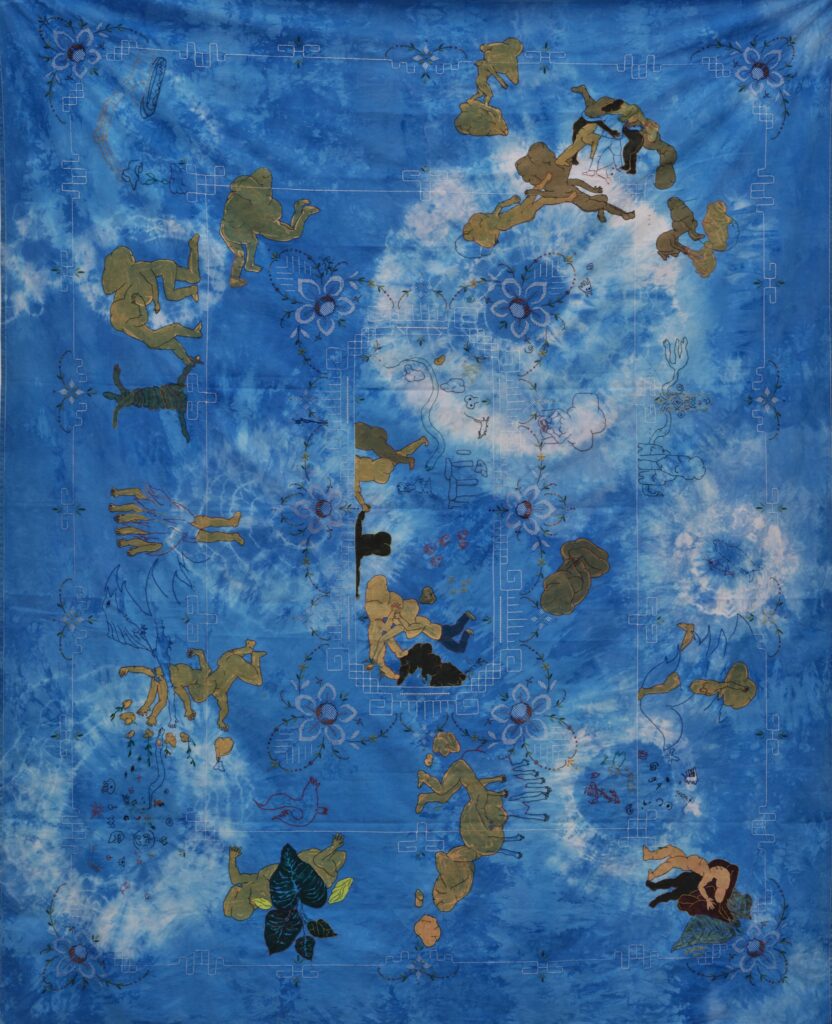JAMILA ABDEL-RAZEK, Art & Design sub-editor, explores the intricate tapestries of GÖZDE ILKIN at Frieze London
I scramble beneath the billowing white tarp, making way for sweeping brooms and unfurling carpets. It’s rather strange seeing Frieze London on installation day, without the glasses of champagne and the babbling of parading VIP tours. I ask where I can find booth H19 over the sounds of drilling, searching for the booth of Gypsum, the Cairo-based gallery. Turning a couple more corners, I finally meet Aleya, the incredible gallery’s founder who quickly introduces me to the Istanbul-based artist.
Gözde Ilkin had on striking Klein blue eyeliner. She moved with such ease, hammer and nails in hand, thread wrapped around her neck. She seemed slightly reserved, extremely kind and concerned with getting the work up in time. As I look past Gözde, I see the works from her solo booth for the first time.
They appeared as topographical maps with animalistic forms seeping through the fabrics. Hallowed tracings of bodily forms emerged from the fabrics as blotted, almost foetus-like – preceding time and gender. Each time you look back to the pieces they reveal something subliminal, even subterranean.
Struck shy with the periodic silences from the sheer focus of the team, I try to be as helpful as possible. As we steam, stretch and hang Gözde’s fabric works, they feel all the more precious as they crinkle and absorb droplets of water. I try to get as close as I can to her embroidered and dyed domestic fabrics, studying their backs where thread hangs so bare and delicate. The freshly steamed tablecloths and pillowcases seem to slowly take their shape on the walls, as if they were to be spread on a dining table or hugging bed pillows.
Once the works are up, Gözde picks up a needle and thread to weave in the final details, whether they be her signature or aquatic animal-looking forms. Standing behind her free-hanging works, I watch as her arm appears through the fabric, and how easily she is woven into the pieces. With such conviction and habit, tracings float towards the surface.

Later the Gypsum team and I go for dinner with Gözde to speak about her work. I sit quite pathetically beside her with a pen and notebook in hand hurriedly writing down every word she says. Initially, she seemed quite shy speaking about her work, searching for the words in English.
She spoke of fabric acting as a stage, as a memory object. Exploring how domestic fabrics pertain to an archival element, Gözde recounts the constant movement and uprooting of her family she experienced growing up. She gained a certain sense of attachment to domestic objects and fabrics which her family used to stage a consistent portrait of home wherever they may be. Using vintage curtains, pillowcases and tablecloth fabrics, some that were given by her mother or by friends on her travels, Gözde creates a repository for memory, whether it traces a certain historiography or fabricates the feelings of home.

Beyond the storage of memory through human attachment to objects, Gözde produces an archive of elements and textures in nature – providing them with a material history. By hand-dying her works with natural pigments and plant extracts, Gözde’s work forges symbiotic relationships between plants, animals and humans. Gözde further explores the ways in which humans once inhabited caves, and hopes to create sanctuaries for stones through her soft sculptures, giving them a home. Tracing the characters of stones and researching their ancient symbology, she looks to archive the earth’s memory.
The act of embroidering, inscribing and stitching on such fabrics accesses a collective memory and rediscovers a certain sense of loss. Her production of distorted, humanoid forms appears similar to early cave paintings and mythological depictions. Her elemental symbolic language seems to trace the very origins of what it means to be human before anything else.

After saying my goodbyes to Gözde, I felt as if I knew her, that I had learned about her childhood, about her fondness towards such memories. Having experienced a new attachment to the works, seeing them held, folded, and wrinkled, I felt it was a shame that Frieze was going to sum up the work in a mere two sentences that would never encapsulate the complete care and kindness of Gözde’s practice. Despite the commercial nature of Frieze London, I watched with attentiveness how fair visitors were drawn to her work, and how they felt the frequency her fabrics exuded. The act of embroidery, as I felt it to be watching Gözde embed herself into her work, allows her to physically attach herself and all viewers to such objects, memories, and mythologies to stage a belonging with histories that long precede us.







